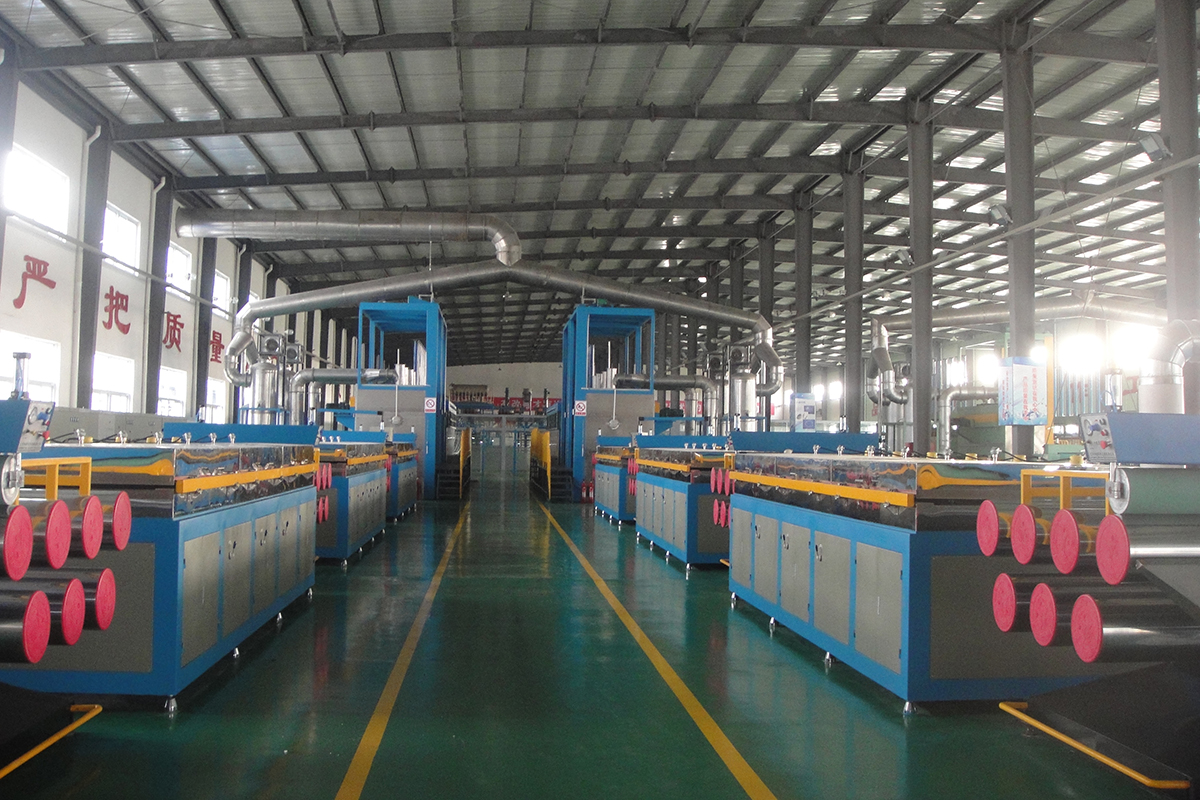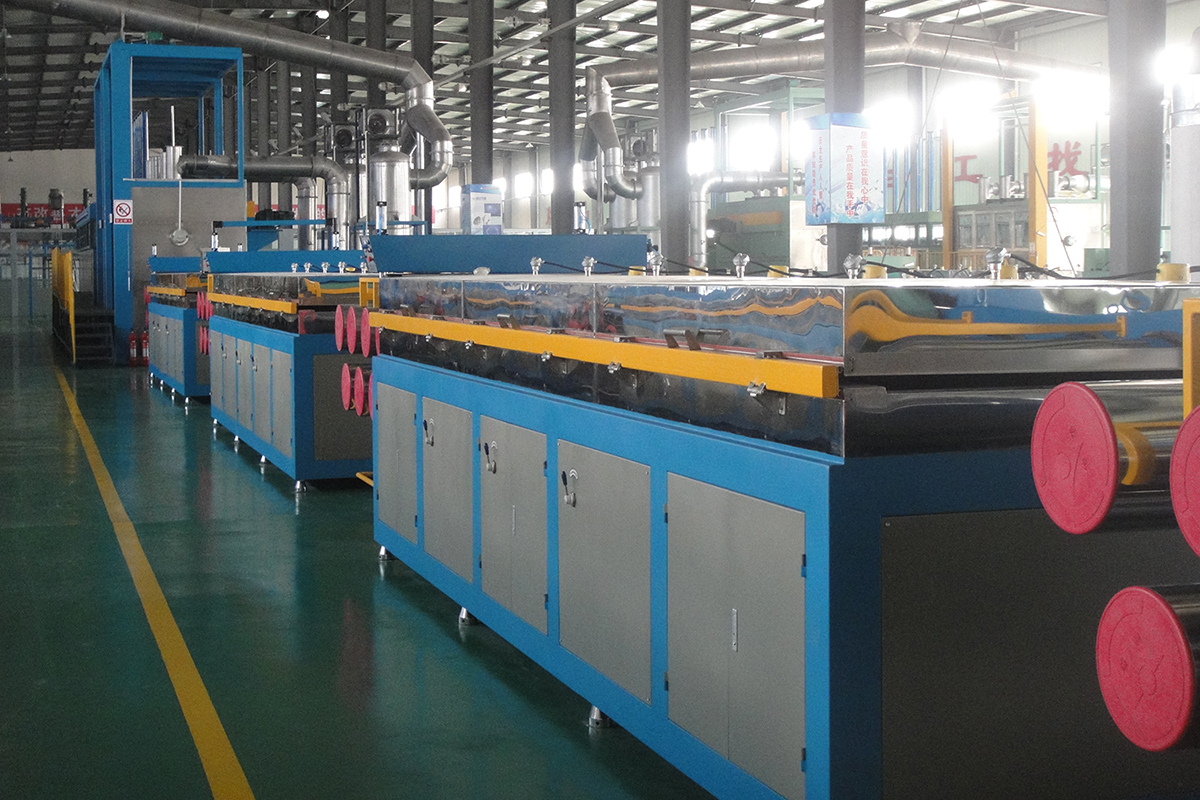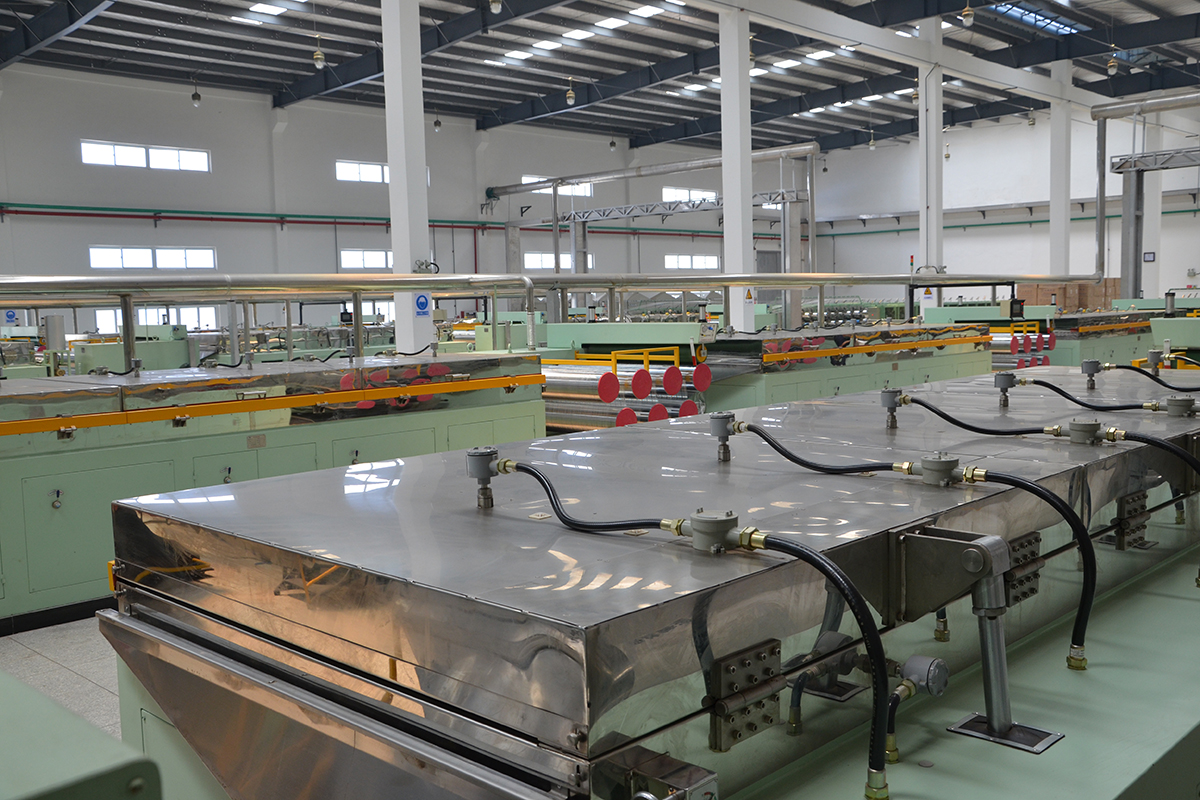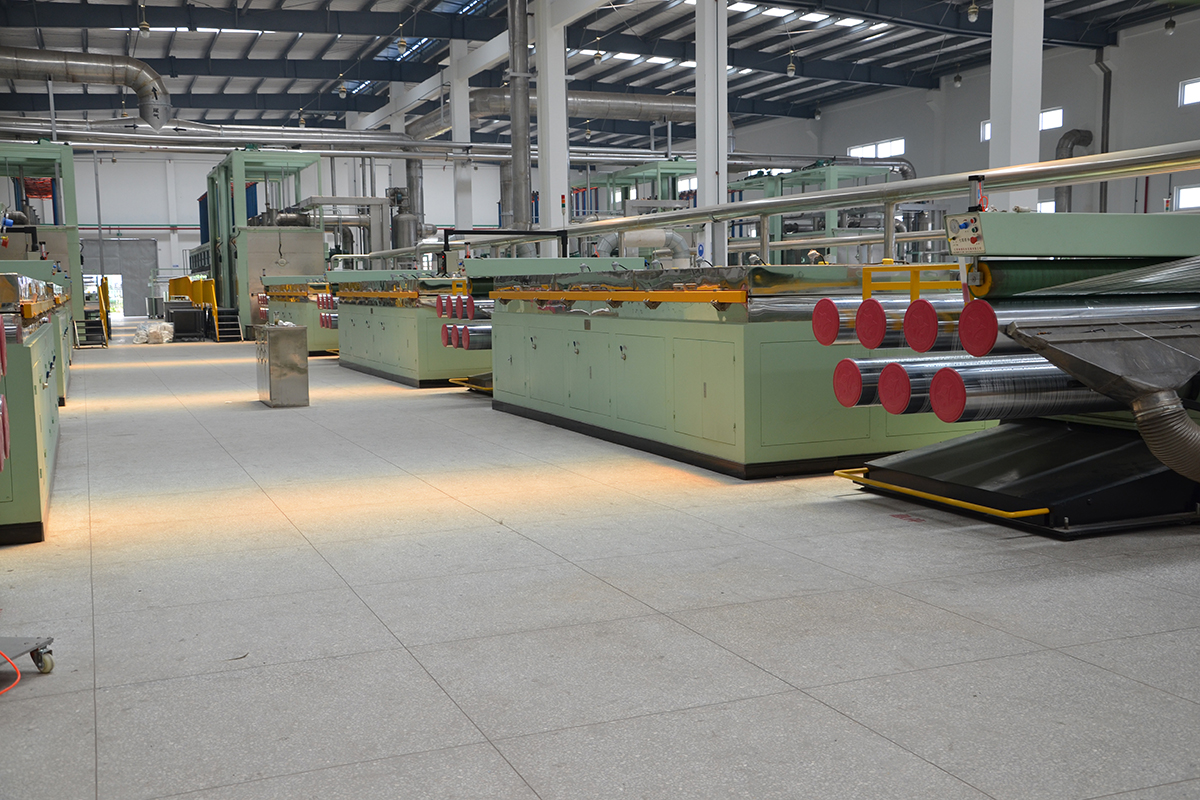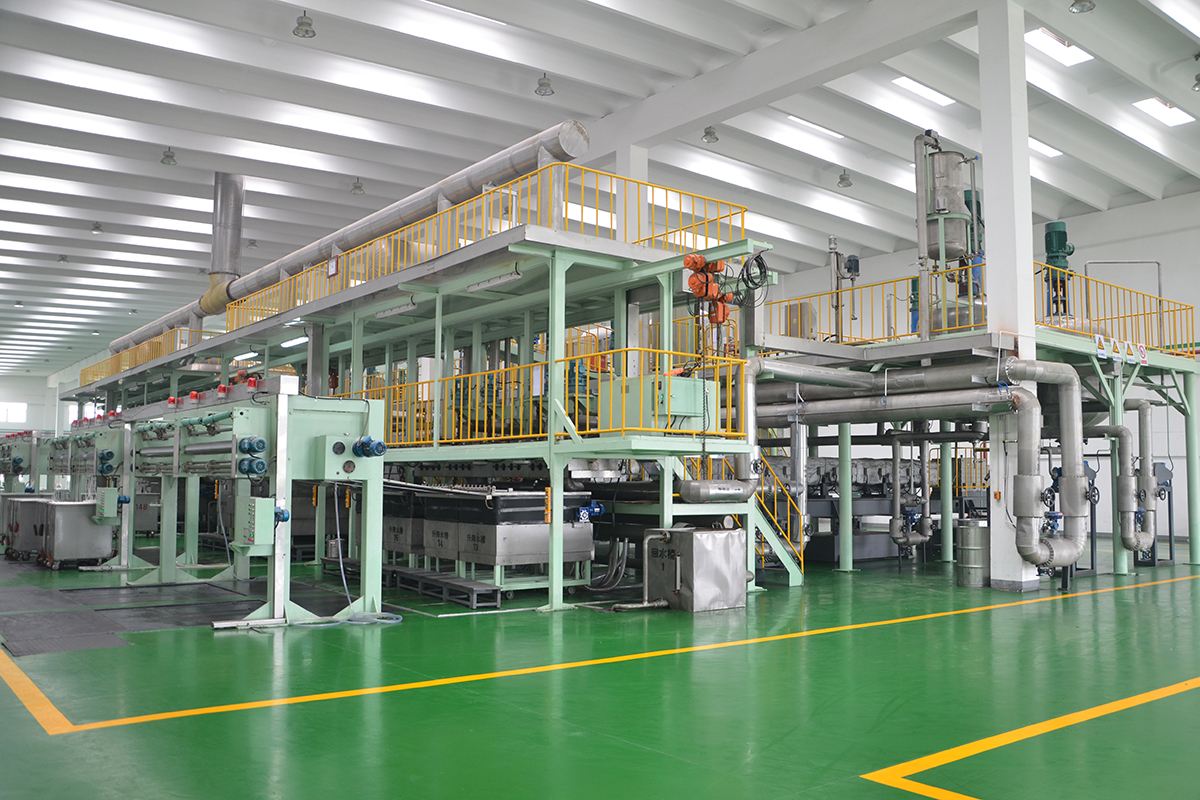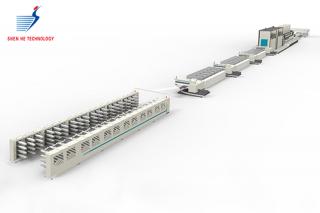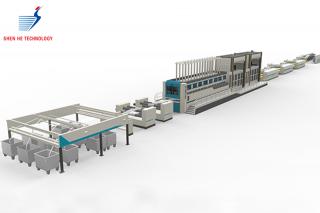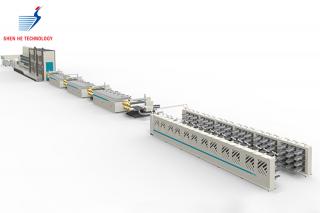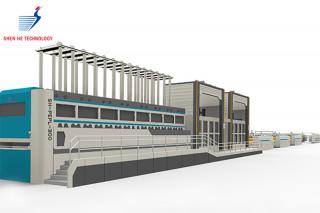-
This high-strength and high-modulus polyethylene fiber production line uses ultra-high molecular weight polyethylene as a raw material, mineral white oil as a solvent, uses a gel spinning process to make primary fibers, and then makes ultra-high-strength high-modulus polyethylene fibers through super-stretching. Production process includes: front spinning (ingredient, spinning, balance), post spinning (pre-drawing, extraction, drying, drafting, winding, inspection), recycling (oil-water separation, white oil recovery, gas recovery, extraction agent separation) , Packaging and storage.
1. Front spinning:
-
Ingredients: Ultra-high molecular weight polyethylene powder is mixed with white oil and antioxidant in a certain proportion, and then uniformly and constant pressure is added to the twin-screw extruder through the pipeline. Spinning: The ultra-high molecular weight polyethylene macromolecular concentrated solution fully dissolved by the twin-screw extruder is accurately measured and extruded from the spinneret hole of the spinning box, and enters the constant temperature frozen water, and the temperature of the raw silk is exchanged by heat exchange. Quickly descend to obtain frozen collagen filaments, and place the frozen collagen filaments in an overlapping and orderly order in a silk bucket. Equilibrium: The solid-liquid phase separation and stress relief balance are carried out in the jelly wire barrel in a constant temperature space for about 24 hours.
2. After spinning:
-
Bundle: Parallelly and uniformly pull out the gelatin tow after standing.
Pre-drawing: The pre-tensioned jelly filaments drawn from the bundle are fed into the extraction process smoothly after applying pre-tension in parallel..
Extraction: The solvent inside the frozen collagen silk is completely extracted in the extraction equipment..
Drying: The constant-temperature circulating air is used to dry the extractant on the surface of the tow to obtain the dried raw silk..
Drafting: Three-stage thermal drafting is performed on the dried tow, so that the ultra-high molecular weight polyethylene tow has high strength and high mold mechanical properties..
Winding: Untwisted constant tension winding equipment is used to wind and mold the ultra-high molecular weight polyethylene high-strength and high-mold tow..
Inspection: UHMWPE tow is tested for various physical indicators.
3. Recycling:
-
Oil-water separation: This device is designed to fully separate the oil-water mixture due to phase separation when the jelly wire is balanced during fiber production. The device uses the principle of small molecule agglomeration and the principle of shallow ponds to quickly separate white oil from water. The separated white oil enters the system for recycling after treatment, and the separated water can be directly recycled. White oil recovery: It is the white oil to be treated which is separated from oil and water and extractant, and is recovered by white clay adsorption method. Use a pump to pump the white oil to be refined in the white oil tank to be refined into the refining stirred tank, and add a certain amount of food-grade white clay. After stirring, a uniform suspension is formed and raised to a certain temperature. The impurities are then filtered and finely filtered to filter out the white clay that has adsorbed impurities in the suspension, and the remaining pure white oil is pumped into the white oil storage tank for recycling.
Gas recovery: Extraction and drying of the gas containing the extractant, and the use of activated carbon to adsorb the extractant. After the activated carbon is saturated with adsorption for a period of time, the activated carbon is regenerated using steam. After the steam purges the activated carbon, the steam containing the extractant is condensed into a liquid through a condenser, separated into the extractant storage tank by specific gravity, and the water is pumped back to the pool. Dry hot activated carbon with hot air to make it better for the next step of adsorption. Extraction agent separation: The difference between the boiling point of the extractant and white oil is used to separate the extractant and white oil through a vacuum distillation system. The low-boiling extractant is separated from the mixed liquid in a gaseous form by heating and heating, and then condensed and sent to the extractant storage tank for recycling. The remaining high-boiling white mineral oil in the system is processed by the white oil to be refined. Transfer to white oil storage tank.
Second, the annual output of a single production line Taking the 400D specification as an example, the annual output of each high-strength high-modulus polyethylene fiber production line is 300 tons (the actual annual output can reach 350-400 tons). Introduction to main equipment and plant area The front and back spinning main equipment of a one-to-two high-strength high-modulus polyethylene fiber production line covers an area of about 150 meters × 20 meters (including 40 meters × 20 meters for the front spinning, 11 meters under the beam, and 110 meters for the rear spinning × 20 meters, 9 meters below the beam).
High-strength high-modulus polyethylene fiber production line Generally, there are at least two one-stroke two high-strength high-modulus polyethylene fiber production lines in the factory area, with an annual output of 600 tons. The plant occupies an area of 40 acres (158 meters long x 172 meters wide, totaling 27,200 square meters).
Staffing of a high-strength high-modulus polyethylene fiber production line:
- 1. Fore spinning: 4 people
- 2. After spinning: 6 people
- 3. Recovery: 2 people
- 4. Total staff: 12 people / class (excluding packaging, physical inspection and testing, administrative office, management staff).
Staffing of two high-strength and high-modulus polyethylene fiber production lines:
- 1. Fore spinning: 5 people
- 2. After spinning: 12 people
- 3. Recovery: 3 people
- 4. Total staff: 20 people / class (excluding packaging, physical inspection and testing, administrative office, management staff).
V. Electricity consumption and environmental protection
-
1. Electricity consumption per ton of fiber: 18000-25000kw / ton of fiber.
2. The discharge and noise generated during the production process are in compliance with (GB8978-1996) Grade I Standard for Integrated Wastewater Discharge Standard, (GB3095-1996) Grade A Standard for Ambient Air Quality Standard, and (GB3838-2002) Ground Surface Water Environment Quality Standards ", (GB3096-2008)" Acoustic Environment Quality Standards ", (GB12348-2008)" Environmental Noise Emission Standards for Industrial Enterprises ", (GB16297-1996)" Integrated Emission Standards for Air Pollutants ". -
1.Exhaust gas
The exhaust gas comes from the gas recovery process. The gas (steam or air) is entrained into the atmosphere with a small amount of cleaning agent and solvent. Because it is an environmentally friendly cleaning agent, the gas emissions meet environmental protection requirements. -
2. Wastewater
Wastewater pollution sources include production sewage and domestic sewage. The sewage is discharged to the company's existing sewage treatment device, and after passing the pretreatment, it is discharged to the sewage treatment plant in the park for treatment, and the domestic sewage is discharged into the sewage pipe network system in the park. -
3. Waste liquid, waste residue, waste silk
The waste residue mainly comes from the defective products in the production process. After the waste jelly silk is extracted and dried, it becomes waste silk. The waste silk is collected for sale and the solvent used for extraction is returned to the production system for unified treatment. It is produced during the white oil refining process. The waste white clay is recycled by the white clay supplier. The domestic waste is entrusted to the sanitation department for regular cleaning and transportation for sanitary landfill. -
4.Noise
The main noise sources in the production process and public and auxiliary projects are: stirred tank noise, draft machine noise, air compressor noise, refrigerator noise and fan noise.
The main noise prevention measures adopted in this project:
① Use low-noise equipment whenever possible.
② Reasonable layout of the factory area, the strong sound source equipment should be far away from the factory boundary, and local sound insulation and noise reduction processing should be performed for the strong sound source.
③ The workshop adopts overall sound insulation measures. The lighting doors and windows adopt double-layer sound insulation doors and windows, and the sound insulation ability of the workshop wall is considered in the architectural design, and building materials with strong sound insulation ability are used.
④ Tree planting around the plant area.
Special properties of ultra high molecular weight polyethylene fibers
-
Ultra high molecular weight polyethylene fiber (full name in English: Ultra High Molecular Weight Polyethylene Fiber, UHMWPE for short), also known as high-strength high-modulus polyethylene fiber, is currently the world's highest specific strength and specific modulus of fiber, its special properties are:
1. High specific strength and high specific modulus. The specific strength is more than ten times that of the steel wire with the same cross-section, and the specific modulus is second only to the special grade carbon fiber.
2. The fiber density is low, the density is 0.97g / cm3, and it can float on the water.
3. Low elongation at break, large work at break, and strong ability to absorb energy, so it has outstanding impact resistance and cutting resistance.
4, anti-ultraviolet radiation, anti-neutron and gamma rays, high specific energy absorption, low dielectric constant, high electromagnetic wave transmission.
5, chemical corrosion resistance, wear resistance, long flex life.
|
Strength |
28~40g/d |
|
Mo Xing |
1000~1300g/d |
|
Density |
0.97g/cm3 |
|
Elongation at break |
<3% |
|
Total fineness |
800~2400D |
|
Monofilament fineness |
3.5~4.0D |
|
Hygroscopicity |
none |
|
Boiling water shrinkage |
<1% |
|
Hydrolytic |
none |
|
Acid resistance |
good |
|
Alkali resistance |
good |
|
Resistance to other chemicals |
good |
|
UV resistance |
good |
|
Melting point |
144~155° C |
|
Thermal conductivity (along the fiber axis) |
20w(mk) |
|
Thermal coefficient |
-12*10-6k |
|
Resistance |
>10 14 Ω |
|
Dielectric strength |
900KV/CM |
|
Dielectric Constant ((22 ° C, 10Ghz) |
2.25 |
|
Loss factor |
2*10-4 |
|
Fusibility (22C. 20% load) |
1*10-2%d |

